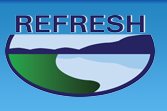International
Last Updated:

5. Project Title: PONDERFUL: Pond Ecosystems for Resilient Future Landscapes in A Changing Climate
Project Information
The Middle East Technical University is part of a consortium that is running a new Horizon 2020 project 'PONDERFUL', led by the University of Vic (Spain). The project's overarching aim is to develop improved methods for maximising the use of ponds and pondscapes in climate change adaptation and mitigation, biodiversity conservation and the delivery of ecosystem services.
Project ID: 869296
Duration: 12/2020-12/2024
Funded under: H2020-EU.3.5.1. and H2020-EU.3.5.2.
Overall budget: € 6 993 407,50
Coordinated by: FUNDACIO UNIVERSITARIA BALMES, Spain
Objective
Because of their small size, the significance of ponds has long been underestimated. They are, for example, largely excluded from the Water Framework Directive in Europe, even though the Directive is actually intended to protect 'all waters'. In North America, their inclusion in the protections provided by the Clean Water Act is contested, and in other areas they lie largely outside regulatory systems. However, research over the last 10-15 years has shown that, because of their abundance, heterogeneity, exceptional biodiversity, inherent naturalness and biogeochemical potency, ponds play a role in catchments, landscapes, and potentially at continental scale which is completely out of proportion to their small size.
The main aims of the research in PONDERFUL will be to increase understanding of the ways in which ponds, as a Nature-Based Solution (NBS), can help society to mitigate and adapt to climate change, protect biodiversity and deliver ecosystem services. The project starts in December 2020, and runs for 4 years.
The project has five main components:
1. Developing a strategic approach to engagement with stakeholders, to ensure that they are able to effectively implement the benefits of ponds as Nature-Based Solutions
2. Through the generation of extensive new biodiversity and ecosystem services datasets, to better establish the relationship between pond biodiversity and the delivery of ecosystem services
3. Establish models that enable us to test and optimise practical scenarios for the use of ponds and Nature-Based Solutions
4. Create a set of demonstration sites across Europe which show to practitioners and policy makers how ponds can help to mitigate and adapt to the effects of climate change
5. Ensure that the project's outputs are widely known to policy makes, practitioners and other stakeholders.
Project Partners: The University of Vic - Central University of Catalonia; IGB Leibniz-Institute of Freshwater Ecology and Inland Fisheries; Katholieke Universiteit Leuven; Haute Ecole Specialisée de Suisse Occidentale; Universitat de Girona; Ecologic Institute, Berlin; University College London; Middle East Technical University; CIIMAR - Centro Interdisciplinar de Investigação Marinha e Ambiental; Aarhus Universitet; Uppsala Universitet; Bangor University; Technische Universitaet Muenchen; Institut Superieur d'agriculture Rhone Alpes I.S.A.R.A; Freshwater Habitats Trust; Universidad de la Republica, Uruguay; Randbee Consultants and Amphi International.
The project brings together experienced researchers from nine European states and Uruguay. Middle East Technical University is very pleased to be one of the 18 project partners who are working together to deliver this important and innovative project.
PONDERFUL is committed to gender balance and gender mainstreaming through the project actions and content and we are pleased to note that the current consortium team is 53% female.
More information here: https://cordis.europa.eu/project/id/869296
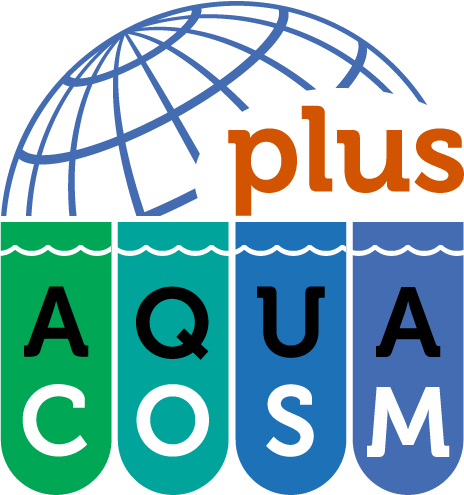
4. Project Title: EU H2020-INFRAIA-Network of Leading Ecosystem Scale Experimental AQUAtic MesoCOSM Facilities Connecting Rivers, Lakes, Estuaries, and Oceans in Europe and beyond
Acronym: AQUACOSM-plus
Project Information
AQUACOSM-plus is an EU funded project which is conducted as part of the H2020-AQUACOSM Project. AQUACOSM-plus aims to efficiently address the dramatic challenges aquatic ecosystems are facing by providing, to a broad multidisciplinary international research community, an open-access, high- quality and innovative European-driven research infrastructure, supporting excellent research and fast-track to innovation, and bringing together a research community specialized in experimental mesocosm-based research, covering freshwater and marine ecosystems from the Arctic to the Mediterranean. AQUACOSM-plus aims to go far beyond the achievements of its predecessors which are ongoing H2020 AQUACOSM Project (2017-2020) and FP7-funded network MESOAQUA (2009- 2012).
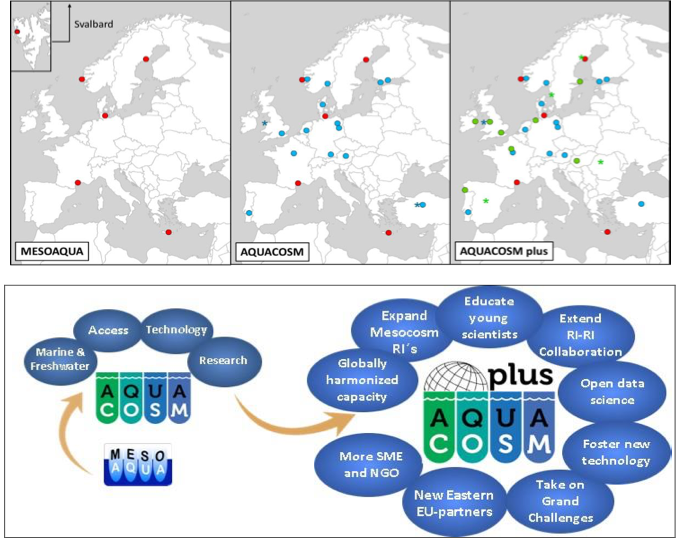 Duration: 04/2020- 03/2024
Duration: 04/2020- 03/2024
Funded by: European Commission, Research and Innovation, Budget 9,999,563 €
Directorate: Dr. Jens Nejstgaard (coordinating institution (FVB-IGB) and the scientific coordinator), nejstgaard@igb-berlin.de, Dr. Stella Berger (deputy coordinator), berger@igb-berlin.de
Project partners: See www.aquacosm.eu/mesocosms website for the partners and their facilities.
As a partner of AQUACOSM-plus, METU offered to access to the full range of laboratories and instrumentation available at the METU Mesocosm System and METU Limnology Lab, physical, logistic, technical and scientific support will be provided for all researchers via Transnational Access. Professor Meryem Beklioğlu lead "WP3", tasks 6.2, 9.3, and contributor to all WPs. For detailed information, you can visit www.aquacosm.eu
The upper figure shows that AQUACOSM-plus mesocosm facilities in terms of partners with including its predecessors as FP7 MESOAQUA and H2020 AQUACOSM (upper panels), and demonstration of activities (lower panel).
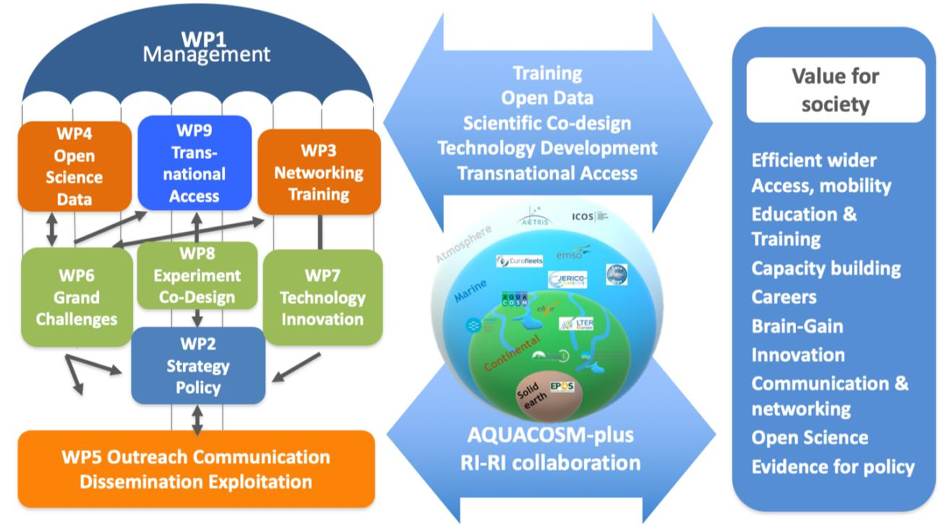
Graphical demonstration of work packages including "WP3", relations between the AQUACOSM-plus WPs, related RIs, and expected output on the left side
Project Information
Aquatic research is still divided in marine and freshwater sciences, with separate funding sources, and experimental science is often conducted at single sites without international coordination. to challenge these problems, the FvB-IGB-lead project AQUACOSM is funded by the first international call (EU H2020-INFRAIA) to coordinate research, develop common best practices and open both freshwater and marine large-scale research infrastructures (mesocosms) for international cross-discipline participation.
Project Title: EU H2020-INFRAIA-project No 731065 "AQUACOSM: Network of Leading European AQUAtic MesoCOSM Facilities Connecting Mountains to Oceans from the Arctic to the Mediterranean"
Duration: 01/2017-12/2020
Funded by: European Commission, Directorate-General for Research & Innovation, Budget 9,999,807 €
Direction: Dr. Jens Nejstgaard (Project leader), nejstgaard@igb-berlin.de, Dr. Stella Berger (Transnational Access leader), berger@igb-berlin.
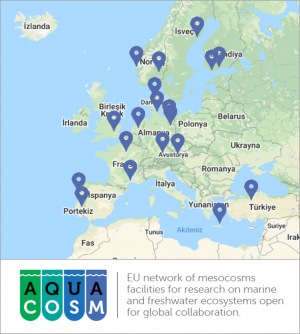
Project partners: Aarhus University, AREFSENS Electronics Inc., Blue Lobster IT Ltd, Centro de Biodiversidade e Recursos Genéticos – Universidade de Évora, CNRS – MARine Biodiversity-Exploitation and Conservation, Ecole Normale Supérieure, Finnish Environment Institute-Marine Research Centre, Forschungsverbund Berlin e.V. – Leibniz-Institut für Gewässerökologie und Binnenfischerei, GEOMAR Helmholtz Centre for Ocean Research Kiel, Hellenic Centre for Marine Research, Imperial College of Science Technology and Medicine, Ludwig-Maximilians-Universität, Middle East Technical University, Netherlands Institute of Ecology, Norwegian Institute for Water Research, Umeå Marine Science Center, Umweltbundesamt, Uni Research AS, University of Bergen, University of Helsinki-Tvärminne Zoological Station, WasserCluster Lunz-Biologische Station GmbH
As a partner of AQUACOSM, METU MESOCOSM SYSTEM hosts researchers worldwide and together they conduct research on the impacts of climate change in freshwater ecosystem using METU Mesocosm System. For more information on the AQUACOSM project, please visit the project website at https://www.aquacosm.eu/.
AQUACOSM PROJECT 2021 EXPERIMENT
Determining the effects of high DOC and warming on the microbial and planktonic food web structure and efficiency
Time and Location
The 2021 mesocosm experiment was conducted for 31 days at METU Mesocosm System I (MMSI) at METU Experimental Lake (Lake Golet) between 05 July-05 August.
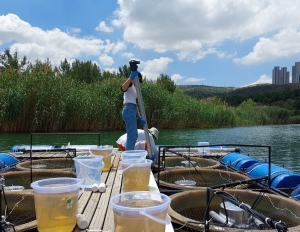
Objective
The primary objective of the experiment is to investigate the responses of the system to dissolved organic carbon (DOC) and warming as a climate change impact. Globally, freshwater ecosystems are warming at unprecedented rates and are simultaneously experiencing increased runoff of DOC (brownification) through flash floods, with little known consequences for future conservation of biodiversity and ecosystem functioning of freshwater lakes. In aquatic systems, phytoplankton (autotrophs) and bacteria (heterotrophs) are basal producers, acting as energy source for higher trophic levels, and thus shape the food webs depending on their production and composition. The increased input of dissolved organic carbon with brownification can further support mixotrophic algae which are at a competitive advantage over obligate phototrophs, as they can utilise bacterial prey as a source of carbon and energy and overcome growth limitations imposed by low-light conditions from the brownification. Having the already available nutrient advantage with their high metabolic rates hand small size, bacteria and consequently microbial loop (ML) can dominate the traditional food web.
Hypothesis
We hypothesized high temperature and DOC levels;
1. give advantages heterotrophic, as compared to photoautotrophic processes, that mixotrophs can be favored.
2. competitive interactions among different phytoplankton taxa and thereby to reduce overall phytoplankton species as well as their trait richness. Loss of traits related to resource use and growth, which can have a serious outcome for ecosystem functioning, food web dynamics and trophic transfer efficiencies.
3. Impact of grazing pressure of large zooplankton grazers may also change the outcome of competitive interactions among different phytoplankton taxa
4. heterotrophic basal production will be enhanced and this will affect the food web efficiency (FWE) through energy transfer to higher trophic level (zooplankton) since bacteria are thought to be of poor nutritional quality.
Experimental Set-up
We performed a mesocosms experiment in a full factorial design with DOC, heating, heating + DOC treatments and controls each replicated 4 times for a month from 5 July to 5 August 2021. We had food wed structure having communities from bacteria to fish level. DOC was obtained from local sources (Alder Tree Leaves) to be 8 mg/L to simulate flash flood events. Half of the mesocosms were heated to a + 4oC of controls using an automation system.
We performed 13 samplings including physiochemical parameters as well as biological parameters such as environmental DNA (eDNA), chl-a, bacteria, phytoplankton and zooplankton. We will quantify changes in bacteria, phytoplankton and zooplankton in terms of community function and community composition. We will characterize the resistance of the different communities to the DOC pulse and warming. Water chemistry analyses are already completed and future microscopic and eDNA inspection of ML communities (bacteria, HNF, ciliate) and plankton will be used to understand abundance, community composition and trait diversity (16 &18SrRNA). Both micro- & mesozooplankton community structure, and biomass will be determined. Metabolism will also be calculated.
AQUACOSM PROJECT 2019 EXPERIMENT:
Dissolved Organic Carbon(DOC)– Impacts of Pulsed DOC Disturbance in shallow freshwater lakes
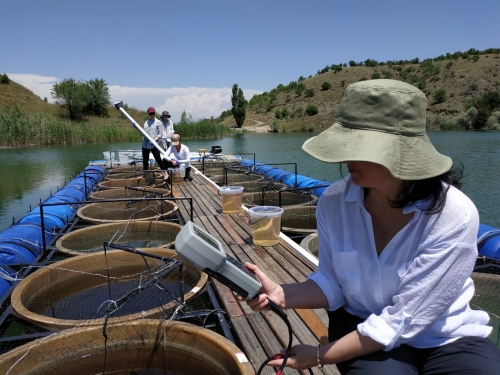
Time and Location The 2019 mesocosm experiment was conducted at METU Mesocosm System (aquatic) at METU Experimental Lake (Lake Golet) between 20 June – 26 July 2019.
Objective
The primary objective of the experiment is to investigate the responses of the system to dissolved organic carbon (DOC) pulses from terrestrial sources as a part of Joint mesocosm experiments of Aquacosm (JOMEX). Through the changes in precipitation pattern in the eastern Mediterranean lately, winter snow packs have been largely replaced with early and late spring heavy rains and intensive flush floods. Such conditions increase transport of matter from terrestrial environments into aquatic systems is a highly relevant aspect of global change even in Eastern Mediterranean in Turkey
Hypothesis
We investigated the response of different plankton communities to a pulsed DOC disturbance and followed the reaction of the system after this strong disturbance in terms of resistance, resilience and recovery (i.e. ecosystem stability concept). We hypothesized that 1) DOC will cause compositional and/or functional shifts in the communities following resistance, resilience, recovery stages, 2) the effects of these shifts will be transferred throughout the food web, 3) systems with high initial functional diversity will have a faster recovery towards initial conditions
Experimental Set-up
For this purpose, METU Mesocosm System at Lake Golet was used with 16 mesocosms with 4x4 design. In order to simulate the effects of terrestrial DOC, two different DOC source was tested: (i) Local DOC extracted from Local Alder Tree Leaves to test the nutrient effect of terrestrial DOC on freshwater systems (ii) Humin Feed (Humintech GmbH), which is a highly standardized product that is used to test light limitation effect of DOC on freshwater systems. Therefore, Mesocosm System included 16 mesocosms with 4 Controls, 4 replicates including a highly standardized DOC source (4 ppm HF) and 4 replicates including a local, more site-specific DOC source (8 ppm Local DOC) and 4 replicates including both sources (4 ppm HF and 8 ppm Local DOC).
With the aim of understanding whole-ecosystem responses, we investigated physiochemical parameters, microbial community structure (16S-18S rRNA), microbial loop community dynamics (bacteria, HNF, ciliates), phytoplankton and zooplankton community structure, lake metabolism and lake stoichiometry.
International Cooperation
We had TA Access teams with projects MicroMESO, PperDOC, ECMMETU2019 and AlloEcoMetry, comprising scientists from Greece, Turkey, Brazil, Croatia and Ireland.
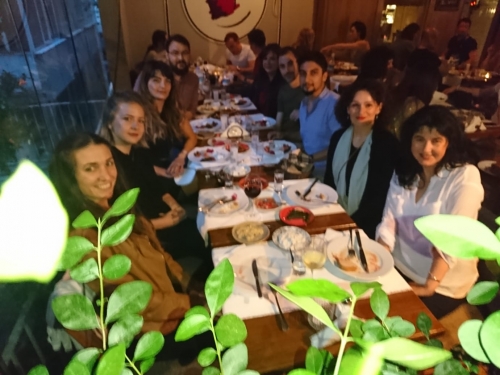
AQUACOSM PROJECT 2018 EXPERIMENT:
MICROPLASTICS– Impacts of microplastics in shallow freshwater lakes
Time and Location: The 2018 mesocosm experiment was conducted at METU Mesocosm System (aquatic) at METU Experimental Lake (Lake Golet) between 18 June – 06 August 2018.
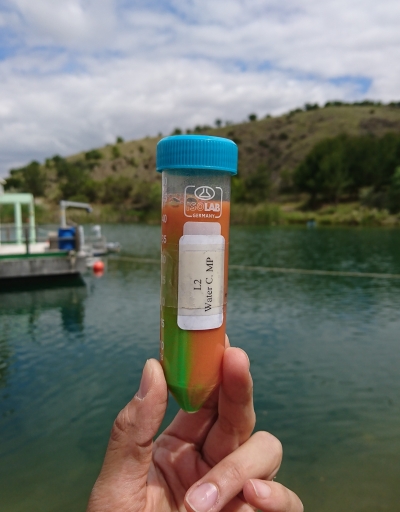
Objective
The primary objective of the experiment was to evaluate the effects of microplastics (MP) in shallow freshwater lakes by exposing surface, water column and sediment of mesocosms simultaneously to the environmentally relevant mixture of various microplastic polymers.
Hypothesis
The following hypothesis were tested in this 2018 mesocosm study (1) MPs found in the water column would stay long enough time be ingested by zooplankton and this ingestion would likely cause a reduction on zooplankton biomass especially in the high concentration; (2) MPs in the sediment would be ingested by the sediment dwelling community that would cause and observable effect of morphometry and emergence pattern; (3) MPs would be transferred between trophic levels through the ingestion of MPs by prey and predation.
Mesocosm Set-up
For this purpose, METU Mesocosm System at Lake Golet was used with 12 mesocosms with 3x4 factorial design. There were 4 tanks with Low MP Dose (L-MP) having environmentally realistic MP concentrations (0.007 g MP/m2 of surface water; 2 g MP/m3 for water column; and 8 g MP/m2 of sediment), 4 future scenario tanks with High MP Dose (H-MP) having 10x higher concentrations than L-MP, and 4 tanks with Control (C) having no MP additions. Based on the available freshwater literature on the composition of microplastics in various compartments, we exposed sediment layer with the following MP composition: 45% polyethylene; 20 % polystyrene; 15% poplypropylene; 10% polyamide; and 10 % polyvinylchloride. On the other hand, surface layer was exposed to 50% polyethylene; 40% poplypropylene; and 10% polystyrene. For the water column, we used fluorescently-labelled polyethylene (50% green polyethylene with 63-75 µm in diameter, 50% red polyethylene with 10-45 in diameter) to track ingestion and transfer of MP between trophic groups.
International Cooperation
We had 2 TA Access teams with projects MICROFREAK and EMPOWER, comprising scientists from Serbia, USA, Czech Republic and UK.
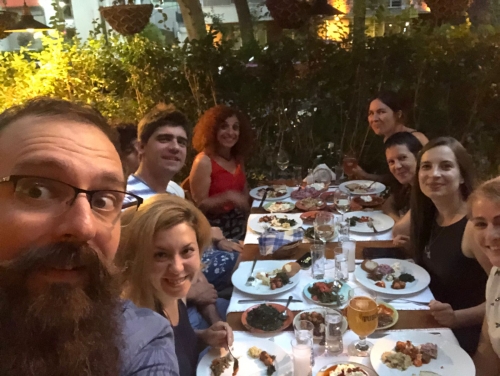
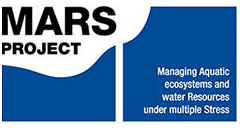
2. MARS- Managing Aquatic Ecosystems and Water Resources Under Multiple Stress
Project Information
MARS is a research project and supports European policies, such as the Water Framework Directive, and the Blueprint to Safeguard Europe's Water Resources. The target of the Project was water managers assessing and restoring rivers and lakes, and policymakers drafting and implementing policies related to water. The main objects of the Project were to understand the effects of multiple stressors on surface waters and groundwaters, their biota, and the services they provide to humans, to understand how ecological status and ecosystem services, to advise river basin management how to restore multiply stressed rivers and lakes, to advise the revision of the Water Framework Directive on new indicators for ecological status and ecosystem services to develop methods and software for the Programmes of Measures.
Duration: 02/2014-01/2018
Funded by: European Union, under FP7-ENVIRONMENT, Grant agreement ID: 603378, Budget: € 11 645 832,84
Project partners: The list of all partners is available on the MARS-partners link of the project. METU as a project partner offered research and training in various fields of limnology throughout Turkey and is carrying out research on the ecology of shallow lakes, impacts of eutrophication, climate change, hydrology (especially water level fluctuations) impacts on ecosystem structure and functions based on community structure. The methodological range includes space for time substitutions, mesocosms experiments, monitoring, paleoecology, and modeling approaches. For detailed information about the MARS project, please visit the project website at http://www.mars-project.eu/index.php.
Publications: In total, 232 papers were published in several journals. Please, check the list below for publications in which Professor Meryem Beklioğlu is also among the authors.
1. Bucak, T., Trolle, D., Tavşanoğlu, Ü. N., Çakıroğlu, A. İ., Özen, A., Jeppesen, E., Beklioğlu, M. (2018). Modeling the effects of climatic and land use changes on phytoplankton and water quality of the largest Turkish freshwater lake: Lake Beyşehir. Science of the Total Environment 621, 802-816, https://doi.org/10.1016/j.scitotenv.2017.11.258
2. Özen, A., Tavşanoğlu, Ü. N., Çakıroğlu, A. İ., Levi, E. E., Jeppesen, E., Beklioğlu, M. (2018). Patterns of microbial food webs in Mediterranean shallow lakes with contrasting nutrient levels and predation pressures. Hydrobiologia 806, 13-27, https://doi.org/10.1007/s10750-017-3329-6
3. Zingel, P., Cremona, F., Nõges, T., Cao, Y., Neif, É. M., Coppens, J., Işkın, U., Lauridsen, T. L., Davidson, T. A., Søndergaard, M., Beklioglu, M., Jeppesen, E. (2018). Effects of warming and nutrients on the microbial food web in shallow lake mesocosms. European Journal of Protistology 64, 1-12, https://doi.org/10.1016/j.ejop.2018.03.001
4. Beklioğlu, M., Bucak, T., Coppens, J., Bezirci, G., Tavşanoğlu, Ü. N., Çakıroğlu, A. İ., Levi, E. E., Erdoğan, Ş., Filiz, N., Özkan, K., Özen, A. (2017). Restoration of eutrophic lakes with fluctuating water levels: A 20 year monitoring study of 2 inter-connected lakes. Water 9, 127, http://dx.doi.org/10.3390/w902012
5. Brucet, S., Arranz, I., Mehner, T., Argillier, C., Beklioğlu, M., Benejam, L., Boll, T., Holmgren, K., Lauridsen, T. L., Svenning, J.-C., Winfield I. J., Jeppesen, E. (2017). Size diversity and species diversity relationships in fish assemblages of Western Palearctic lakes. Ecography 40, 01-12, https://doi.org/10.1111/ecog.03255
6. Brucet, S., Tavşanoğlu, Ü. N., Özen, A., Levi, E. E., Bezirci, G., Çakıroğlu, A. I., Jeppesen, E., Svenning, J.-C., Ersoy, Z., Beklioğlu, M. (2017). Size-based interactions across trophic levels in food webs of shallow Mediterranean lakes. Freshwater Biology 62, 1819–1830, https://doi.org/10.1111/fwb.12997
7. Bucak, T., Trolle, D., Andersen, H. E., Thodsen, H., Erdogan, S., Levi, E. E., Filiz, N., Jeppesen, E., Beklioglu, M. (2017). Future water availability in the largest freshwater Mediterranean lake is at great risk as evidenced from simulations with the SWAT model. Science of the Total Environment 581-582, 413-425, http://dx.doi.org/10.1016/j.scitotenv.2016.12.149
8. Tavşanoğlu, U.N, Šorf, M., Stefanidis, K., Brucet, S., Agasild, H., Boho, D., Scharfenberger, U., Beklioğlu, M., Hejzlar, J., Papastergiadou, E., Adrian, R., Angeler, D., Nõges, T., Çakıroğlu, A. I., Özen, A., Drakare, S., Søndergaard, M., Jeppesen, E. (2017). Effects of nutrient and water level changes on the composition and size structure of zooplankton communities under different climatic conditions: A Pan-European mesocosm experiment. Aquatic Ecology 51, 257-273, http://dx.doi.org/10.1007/s10452-017-9615-6
9. Trochine, C., Brucet, S., Argillier, C., Arranz, I., Beklioğlu, M., Benejam, L., Ferreira, T., Hesthagen, T., Holmgren, K., Jeppesen, E., Kelly, F., Krause, T., Rask, M., Volta, P., Winfield, I. J., Mehner, T. (2017). Non-native Fish Occurrence and Biomass in 1943 Western Palearctic Lakes and Reservoirs and their Abiotic and Biotic Correlates. Ecosystems 21, 395-409, https://doi.org/10.1007/s10021-017-0156-6
10. Boll, T., Levi, E. E., Bezirci, G., Özuluğ, M., Tavsanoğlu, Ü. N., Çakıroğlu, A. I., Özcan, S., Brucet, S., Jeppesen, E., Beklioğlu, M. (2016). Fish assemblage and diversity in lakes of western and central Turkey - role of geo-climatic and environmental gradients, Hydrobiologia 771, 31-44, http:/www.dx.doi.org/10.1007/s10750-015-2608-3"
11. Bucak T., Beklioglu M., Cakiroglu A.I., Erdogan S., Levi E. (2016). Metadata of the Lake Beysehir and Its Catchment, Turkey. Freshwater Metadata Journal 11, 1-8, https://doi.org/10.15504/fmj.2016.11
12. Çakiroğlu, A.I., Levi, E. E., Tavşanoğlu, N., Bezirci,G., Erdoğan, Ş., Filiz, N., Andersen, T. J., Davidson, T. A., Jeppesen, E., Beklioğlu, M. (2016). Inferring past environmental change of three Turkish shallow lakes from community changes of sub-fossil cladocera. Hydrobiologia 778, 295-312, http://dx.doi.org/10.1007/s10750-015-2581-x
13. Coppens J., Hejzlar, J., Šorf, M., Jeppesen, E., Papastergiadou, E., Stefanidis, K., Erdoğan, Ş., Scharfenberger, U., Mahdy, A., Nõges, P., Tuvikene, A., Baho, D. L., Trigalj, C., Olsen, S., Beklioğlu, M. (2016). The influence of nutrient loading, climate and water depth on nitrogen and phosphorus loss in shallow lakes: a pan-European mesocosm experiment. Hydrobiologia 778, 10-32, http://dx.doi.org/10.1007/s10750-015-2505-9
14. Coppens J., Özen, A., Çakıroğlu, I., Tavşanoğlu, Ü. N., Yozgatlıgil, C., Jeppesen, E., Beklioğlu, M. (2016). Impact of alternating wet and dry periods on long-term seasonal phosphorus and nitrogen budgets of two shallow Mediterranean lakes. Science of the Total Environment 563–564, 456–467, http://dx.doi.org/10.1016/j.scitotenv.2016.04.028
15. Jovanovic, B., Bezirci, G., Cagan, A. S., Coppens, J., Levi, E. E., Oluz, Z., Tuncel, E., Duran, H., Beklioglu, M. (2016). Food web effects of titanium dioxide nanoparticles in an outdoor freshwater mesocosm experiment. Nanotoxicology 10(7), 902-912, http://dx.doi.org/10.3109/17435390.2016.1140242
16. Levi, E. E., Bezirci, G., Çakıroğlu, A. İ., Turner, S., Bennion, H., Kernan, M., Jeppesen, E., Beklioğlu, M. (2016). Multi-proxy palaeoecological responses to water-level fluctuations in three shallow Turkish lakes. Palaeogeography, Palaeoclimatology, Palaeoecology 449, 553-566, http://dx.doi.org/10.1016/j.palaeo.2016.02.052
17. Havens, K. E., Pinto-Coelho, R. M., Beklioğlu, M., Christoffersen, K. S., Jeppsen, E., Lauridsen, T. L., Mazumder A., Méthot, G., Pinel Alloul, B., Tavşanoğlu, Ü. N., Erdoğan, Ş., Vijverberg, J. (2015). Temperature effects on body size of feshwater crustacean zooplanktion from Greenland to the tropics. Hydrobiologia 743, 27-35, http://dx.doi.org/10.1007/s10750-014-2000-8
18. Hering, D., Carvalho, L., Argillier, C., Beklioglu, M., Borja, A., Cardoso, A. C., Duel, H., Ferreira, T., Globevnik, L., Hanganu, J., Hellsten, S., Jeppesen, E., Kodeš, V., Lyche Solheim, A., Nõges, T., Ormerod, S., Panagopoulos, Y., Schmutz, S. Venohr, M., Birk, S. (2015). Managing aquatic ecosystems and water resources under multiple stress - an introduction to the MARS project. Science of the Total Environment 503-504, 10-21, http://dx.doi.org/10.1016/j.scitotenv.2014.06.106
19. Jeppesen, E., Brucet, S., Naselli-Flores, L., Papastergiadou, E., Stefanidis, K., Nõges, T., Nõges, P., Attayde, J. L., Zohary, T., Coppens, J., Bucak, T., Fernandes Menezes, R., Sousa Freitas, F. R., Kernan, M., Søndergaard, M., Beklioğlu, M. (2015). Ecological impacts of global warming and water abstraction on lakes and reservoirs due to changes in water level and related changes in salinity. Hydrobiologia 750, 201-227, http://dx.doi.org/10.1007/s10750-014-2169-x
20. Olsen, S., Jeppesen, E., Moss, B., Ozkan, K., Beklioglu, M., Feuchtmayr, H., González Sagrario, M., Li, W., Larsen, S. E., Søndergaard, M. (2015). Factors influencing nitrogen processing in lakes: An experimental approach. Freshwater Biology 60, 642-662, http://dx.doi.org/10.1111/fwb.12511
21. Tavşanoğlu, Ü. N., Brucet, S., Levi E. E., Bucak, T., Bezirci, G., Özen, A., Johansson, L. S., Jeppesen, E., Beklioğlu, M. (2015). Size-based diel migration of zooplankton in Mediterranean shallow lakes assessed from in situ experiments with artificial plants. Hydrobiologia 753(1), 47-59, http://dx.doi.org/10.1007/s10750-015-2192-6
22. Çakıroğlu, A.I., Tavşanoğlu, Ü. N., Davidson,T. A., Levi, E. E., Bucak, T., Özen, A., Akyıldız, G. K., Jeppesen, E., Beklioğlu, M.(2014). Relatedness between contemporary and surface sediment subfossil cladocera assemblages in Turkish shallow lakes. Paleolim 52, 367-383, http://dx.doi.org/10.1007/s10933-014-9799-x
23. Özen, A., Bucak, T., Tavşanoğlu, Ü. N., Çakıroğlu, A. İ, Levi, E. E., Coppens, J., Jeppsen, E., Beklioğlu, M. (2014). Water level and fish-mediated cascading effects on the microbial community in eutrophic warm shallow lakes: A mesocosm experiment. Hydrobiologia 740, 25-35, http://dx.doi.org/10.1007/s10750-014-1934-1
24. Olsen, S., Jeppesen, E., Moss, B., Özkan, K., Beklioğlu, M., Feuchtmayr, H., González Sagrario, M., Wei, L., Larsen, S., Lauridsen, T. S., Søndergaard, M. (2014). Factors influencing nitrogen processing in lakes: An experimental approach. Freshwater Biology 60, 646-662, http://dx.doi.org/10.1111/fwb.12511
1. REFRESH- Adaptive Strategies to Mitigate the Impacts of Climate Change on European Freshwater Ecosystem
Project Information
REFRESH is an EU funded project which was built on EU FP6 Project, Euro-limpacs. The main concern of the project is to generate a scientific understanding of the future status of freshwater ecosystems that is dependent on changes in land-use, pollution loading, and water demand. It has been recognized that the measures that need to be taken to restore freshwater ecosystems to good ecological health or to sustain priority species as required by EU Directives need to be designed either to adapt to future climate change or to mitigate the effects of climate. In addition, REFRESH aimed to push forward the science of integrated catchment modeling.
Duration: 02/2010- 01/2014
Funded by: European Union, funded under FP7-ENVIRONMENT, Grant agreement ID: 244121, Budget: € 9 895 943,67
Project partners: The list of all partners is available on REFRESH-partners link of the project website. METU as a project partner conducted long term mesocosm experiments under "Water management and climate change impacts in lakes and reservoirs" (WP3) task. Prof.Dr. Meryem Beklioğlu was lead the experiment carried out in METU. For detailed information about the REFRESH project, please visit the project website at http://www.refresh.ucl.ac.uk/.
METU Team:
Publications: In total, 140 papers were published in several journals. Please, check the list below for publications in which Professor Meryem Beklioğlu is also among the authors.
- Impacts of salinity and fish-exuded kairomone on the survival and macromolecular profile of Daphnia pulex, Bezirci, G.; Akkas, S.; Rinke, K.; Yildirim, F.; Kalaylioglu, Z.; Severcan, F.; Beklioglu, M. , Ecotoxicology, Volume 21, p.601-614, (2012)
- The influence of water level on macrophyte growth and trophic interactions in eutrophic Mediterranean shallow lakes: a mesocosm experiment with and without fish, Bucak, T.; Saraoğlu, E.; Levi, E.E.; Nihan Tavşanoğlu, Ü.; İdil Çakiroğlu, A.; Jeppesen, E.; Beklioğlu, M. , Freshwater Biology, Volume 57, Number 8, p.1631–1642, (2012)
- Eutrophication and Restoration of Shallow Lakes from a Cold Temperate to a Warm Mediterranean and a (Sub)Tropical Climate, Beklioglu, M.; Meerfhoff, M.; Søndergaard, M.; Jeppesen, E. , Eutrophication: causes, consequences and control, p.91-108, (2011)
- Climate change impacts on lakes: an integrated ecological perspective based on a multi-faceted approach, with special focus on shallow lakes, Jeppesen, E.; Meerhoff, M.; Davidson, T.A.; Trolle, D.; SondergaarD, M.; Lauridsen, T.L.; Beklioglu, M.; Brucet, S.; Volta, P.; González-Bergonzoni, I.; others, , Journal of Limnology
- Climate change effects on nitrogen loading from cultivated catchments in Europe: implications for nitrogen retention, ecological state of lakes and adaptation, Jeppesen, E.; Kronvang, B.; Olesen, J.; Audet, J.; Søndergaard, M.; Hoffmann, C.; Andersen, H.; Lauridsen, T.; Liboriussen, L.; Larsen, S.; Beklioglu, M.; Meerhoff, M.; Özen, A.; Özkan, K. , Hydrobiologia, Volume 663, p.1-21, (2011)
- Similarity between contemporary vegetation and plant remains in the surface sediment in Mediterranean lakes, Levİ, E.E.; Çakıroğlu, A.İ.; Bucak, T.; Odgaard, B.V.; Davidson, T.A.; Jeppesen, E.; Beklİoğlu, M. , Freshwater Biology, Volume 59, Number 4, p.724–736, (2014)
- Environmental Warming in Shallow Lakes: A Review of Potential Changes in Community Structure as Evidenced from Space-for-Time Substitution Approaches, Meerhoff, M.; Teixeira-de Mello, F.; Kruk, C.; Alonso, C.; González-Bergonzoni, I.; Pacheco, J.P.; Lacerot, G.; Arim, M.; Beklioğlu, M.; Brucet, S.; Goyenola, G.; Iglesias, C.; Mazzeo, N.; Kosten, S. , Global Change in Multispecies Systems Part 1, 2012///, Volume Volume 46, p.259 - 349, (2012)
- Long-term effects of warming and nutrients on microbes and other plankton in mesocosms, Özen, A.; Šorf, M.; Trochine, C.; Liboriussen, L.; Beklioglu, M.; Søndergaard, M.; Lauridsen, T.L.; Johansson, L.S.; Jeppesen, E. , Freshwater Biology, Volume 58, Number 3, p.483–493, (2013)
- Sediments, not plants, offer the preferred refuge for Daphnia against fish predation in Mediterranean shallow lakes: an experimental demonstration, Tavşanoğlu, N.; Idil Çakiroğlu, A.; Erdoğan, Ş.; Meerhoff, M.; Jeppesen, E.; Beklioglu, M. , Freshwater Biology, Volume 57, Number 4, p.795–802, (2012)


